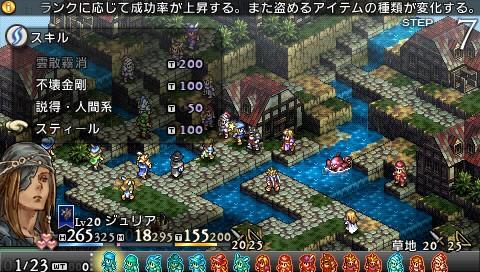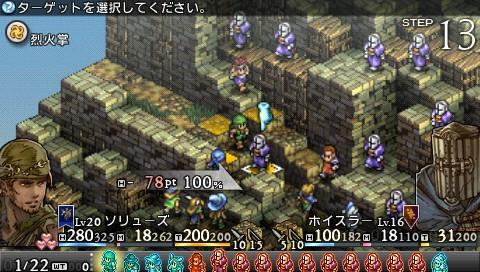Tactics Ogre: Let Us Cling Together Review
Square Enix are pretty big on remaking games. Some might say they do it too often, even - the upcoming PSP release Final Fantasy IV: The Complete Collection will be eighth time that game has been released - but few Square Enix remakes have been met with the enthusiastic response from fans as the announcement of Tactics Ogre: Let Us Cling Together.
A cult classic, Tactics Ogre was the Matsuno written and directed Tactical RPG darling that led to the birth of the Final Fantasy Tactics series and, in a way, Final Fantasy XII. It's hard to believe that the original came out in 1995 - but now, over 15 years later, it's been remastered for PSP.
For US fans Tactics Ogre: Let Us Cling Together is going to be the definitive version of the game from the moment it's booted, as it is base doff the original SNES version of the game rather than the shoddy, slowdown-plagued Playstation version that made it West in 1998.
The result is a game that runs as silky smooth as the cartridge-based original but in glorious widescreen and at a juicy-looking resolution where all the sprites and animations are crisp and clear. If you've seen what Final Fantasy Tactics: The War of the Lions looks like on PSP you'll have a good rough idea of what this game will look like when you boot it up - except Tactics Ogre lacks many of the problems that plagued that port.
It's a pretty game, and those good looks aren't the only thing that's great about the presentation of this remake. The music has been remastered, new characters have been added, and there are new story scenarios to help flesh out certain aspects that were lacking in the original. There's enough changes and new content here to please even someone who obsessed over the original - and that's in addition to the fact that this version of the game looks better and runs just as well as the SNES original.

Past the overhauls to the presentation of the game, the biggest chances to Tactics Ogre actually come to the gameplay. One of the most annoying and pain-inducing gameplay elements in the original was the way the levelling system works. Like many Strategy RPGs, you control a large number of characters and can create new ones pretty much at will - but in the original game every enemy in the game scaled to the level of the strongest character in your team.
You probably know where this is going. If you over-levelled one particular character more than others, you'd of course be in big trouble, and worse than that was trying to level up a low-level character to match the rest of your team - they'd be constantly getting reamed and destroyed by the high-level story characters.
Square Enix have fixed this in the PSP remake by setting levels for each class in one go. Every member of your party, new or old, will match the level of their class overall. Every Ninja will be the level 1 at the start, and instead of levelling individual characters you instead level that 'Class' as a whole. Changing the class of a character will change their level as well to match that class level.
I can hear the hardcore fans screaming out now about this making the game too easy, but, no - I disagree. The way the levelling system worked in the original game as a pain at best and completely unfair at worst, so this is a welcome change. The difficulty of levelling up is still present in a way as newly unlocked classes still debut at Level 1, so if you want to use one of those powerful late-game classes you'll have to grind them out to level them up.
The character skill system has been completely redesigned to ensure players still have a lot of character customization at their fingertips and to ensure that two different Knights, for example, will be significantly different to each other. While battling will level up your classes it also earns you "Battle Points" on a per-unit basis. These battle points can then be spent on acquiring skills.

You're not actually 'buying' the skills, per se - you're equipping them. The amount of Battle Points you have determine how many skills your character can equip. Skills are unlocked via the class level, but the ability to equip higher-level skills must be gained through battling and gaining those Battle Points.
This actually makes the tactical approach to the game take on an entirely new facet - you have to think carefully about what abilities you're going to carry into battle. Even abilities that were automatic before like counter attacking and parrying melee attacks now have to be equipped through this new system. You'll quickly find it's near-impossible to build a powerhouse character that is good at absolutely everything, so you'll have to designate specialized roles to party members and tailor how you fight your battles based on that.
It'd be possible to take a character into battle that has a wide range of attacks to deal with every possible situation, but if you do you'll be taking them out without any powers that buff their power or resistance to physical attacks - so they'll be extremely vulnerable. In the end, it might be wiser to send them out with proficiency in only a couple of types of combat and some buffs to help protect them if they come under attack.
I imagine there'll be a lot of players coming into Tactics Ogre off the back of Final Fantasy Tactics, and those players are in for a shock at just how much more strategic this game is. It truly earns the name Tactics Ogre even in this iteration which is arguably a tad easier than the previous versions of the game.
As well as the changes already detailed, there's the new CHARIOT system which is, long story short, a rewind button. It likes you wind back the combat by up to fifty turns, so if you make a horrific mistake while battling you can go back and correct it. This makes things rather easy, of course, but the game actually makes a point of keeping track of how many of your battles you can complete without using this cheat.
While core fans may balk at this, features like this and the simple tweak of making items that can revive characters more readily available in shops throughout the game will be a saving grace for those more accustomed to some of the easier SRPGs on the market who want to see where many of the genre conventions came from. This, after all, is genesis.
The battles are carried out in finest Strategy RPG tradition with an isometric view, and sprites moving around the screen in a turn-based fashion. The terrain factors in, so Archers and Mages with ranged attacks will perform better from atop a hill and positioning is everything in battle.

Tactics Ogre allows for a whopping 15 units to be deployed into the battle, so things can get pretty hectic if you allow it. To help people understand what's going on Square Enix have also included a new overhead view which lets you get a better look at the position of units on the battlefield at a glance - it's a really great but simple addition.
So, a solid port of an already great game, sensible gameplay tweaks and improvements, nice looking - what's left? Story? Tactics Ogre has that in spades, and it's great.
The original game was really something to behold in terms of the tone and complexity of the story when it was released in 1995 in Japan, and even the rough translation job on the 1998 US release conveyed how amazing the story was - but here we have this story properly, lovingly translated for the first time.
As you'd expect from Matsuno it's a criss-crossing, complex, detailed story of war and political intrigue with some incredibly interesting and well-developed principal cast members. Past that, there's a multitude of great NPCs whose role in the story can change depending on your choices.
The choices you're faced with are often simple, but they can have a significant effect on certain aspects of the story, so you'd do well to pay attention. The whole complex plot requires a lot of concentration, but is ultimately worth it for the sheer quality of the story on offer.
Once you've finished the story, a new option will open up titled WORLD. This allows you to go back in time to pivotal moments in the plot and explore what might've happened if you'd done things a little bit differently.

It's a clever approach, as with Tactics Ogre approaching somewhere between 35 and 40 hours to complete once, few might want to play all the way through again to act differently, but the WORLD system allows you to easily go back - and I can see people getting dragged in for another 30 hours or more just seeing all the possible outcomes to different story events.
There's also a multiplayer mode, but that's the one aspect of this super-enhanced remake that does feel a little tacked on. You can basically download a 'ghost' of another player's team, complete with AI copies their battle tactics - but it's really just a token offering more than anything else. This game is about the single player experience.
What a single player experience it is. From the changes to the battle system to the newly recorded voice acting for cutscenes to the remastered music and the slight tweaks and changes to the in-game graphics, everything about Tactics Ogre: Let Us Cling Together feels very carefully considered and lovingly created, something many remakes lack.
It needs to be understood that despite all those balance changes and tweaks to make it easier Tactics Ogre: Let Us Cling Together is still a niche game. You'll need a love for, well, tactics and micromanagement to truly get a high level of enjoyment out of it, but it truly is the pinnacle of this genre and there's more 'strategy' in this RPG than in many other SRPGs put together.
It's ambitious to take a hugely influential game that helped to shape a whole genre and remake it, but more amazing than that is being able to then make what is without a doubt the definitive version of that title. Anyone who loves depth, difficulty and story in their RPGs owes it to themselves to play this.